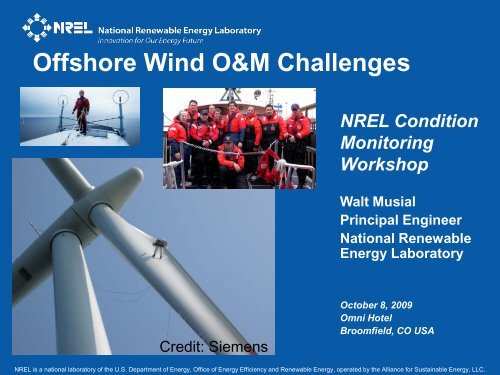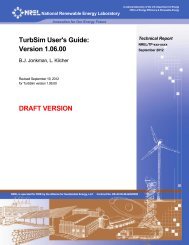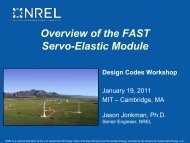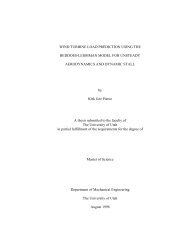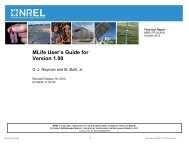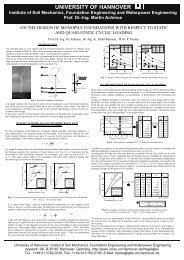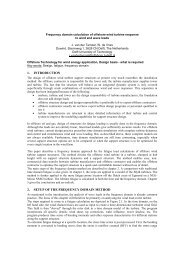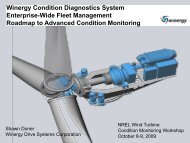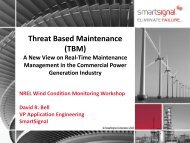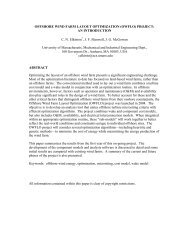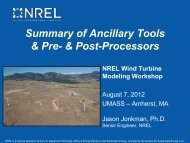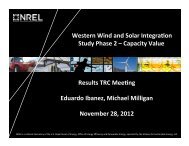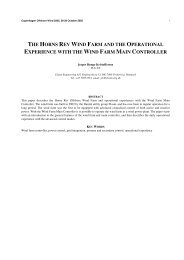Offshore Wind O&M Challenges - NREL
Offshore Wind O&M Challenges - NREL
Offshore Wind O&M Challenges - NREL
- No tags were found...
Create successful ePaper yourself
Turn your PDF publications into a flip-book with our unique Google optimized e-Paper software.
<strong>Offshore</strong> <strong>Wind</strong> O&M <strong>Challenges</strong><strong>NREL</strong> ConditionMonitoringWorkshopWalt MusialPrincipal EngineerNational RenewableEnergy LaboratoryCredit: SiemensOctober 8, 2009Omni HotelBroomfield, CO USA<strong>NREL</strong> is a national laboratory of the U.S. Department of Energy, Office of Energy Efficiency and Renewable Energy, operated by the Alliance for Sustainable Energy, LLC.
1,471 MW installed(Jan 2009)37,442 MW Planned(by 2015)European <strong>Offshore</strong> <strong>Wind</strong>EU <strong>Offshore</strong> <strong>Wind</strong> Targets2010 5,000 MW2015 15,000 MW2020 20‐40,000 MW2030 150,000 MWhttp://www.offshorewindenergy.org/http://www.ewea.org/index.php?id=203
European Project Status…as of January, 2009Belgium 30 MW2%United Kingdon590.8 MW39%Denmark 409.15 MW28%Finland 24 MW2%Germany 12 MW1%Ireland 25.2 MW1%Source: EWEA, 2009Sw eden 133.3 MW9%Ne therlands246.8 MW17%Total:1,471 MW
20% <strong>Wind</strong> by 2030(54,000 MW from <strong>Offshore</strong>)2009http://www1.eere.energy.gov/windandhydro/pdfs/41869.pdf
US <strong>Offshore</strong><strong>Wind</strong> ProjectsUS <strong>Offshore</strong> <strong>Wind</strong> InitiativesProject State MWCapewind MA 468Hull Municipal MA 15Buzzards Bay MA 300Rhode Island (OER) RI 400Hull MunicipalBuzzards BayCape <strong>Wind</strong> AssociatesRhode IslandWinergy NY 12New Jersey (BPU) NJ 350Delmarva DE 350Cuyahoga CountyNew JerseyDelawareSouthern Company GA 10W.E.S.T. TX 150Cuyahoga County OH 20AtlanticOceanTotal MW 2075Southern CompanyNo <strong>Offshore</strong> <strong>Wind</strong>Projects Installed InNorth America YetW.E.S.T. LLCGulf of MexicoProject in Federal WatersProject in State Waters
<strong>Offshore</strong> <strong>Wind</strong>Technology IssuesPhoto Credit: Vestas <strong>Wind</strong> Turbines‣ Corrosion Protection‣ Nacelle pressurization‣ Personnel Access, shelter,and safety‣ <strong>Wind</strong>/Wave StructuralDesign‣ Hurricanes‣ Grids and submarineelectrical infrastructure‣ Condition monitoring andpredictive maintenance‣ Inspection‣ Decommissioning‣ Environmental impacts
Current Technology‣ Fixed bottom shallow water 0-30mdepthPhoto Credit: GE Energy‣ 2 – 5 MW upwind rotor configurations‣ 70+ meter tower height on monopolesand gravity bases‣ Mature submarine power cable‣ Existing oil and gas experience isessential‣ Reliability problems and turbinesupply shortages have discouragedearly boom in development.‣ Costs are 2X land-based due tohigher than expected cost anduncertainty with O&M, logistics, andinstallation.
<strong>Offshore</strong> MaintenanceIssues‣ Vessel deployment costand logistics‣ Accessibility andAvailability‣ Weather <strong>Wind</strong>ows‣ Status and HealthMonitoring‣ ReliabilityCredit: ABBCredit: GE Energy
<strong>Offshore</strong> <strong>Wind</strong> farm MaintenanceEgmond aan Zee<strong>Offshore</strong> demonstration projectsupported by Dutch government– Selection of site– Issue of building permits– Investment subsidy– Production subsidyBuilt and operated by Noordzee<strong>Wind</strong>– 36 Vestas 3 MW V90 windturbines– 1 met mast, 116 m high– Hub height 70 m, rotor diameter90 m– Monopiles with scour protection– Water depth 20 m– 3 x 34 kV cables to the shore– 34/150 kV substation on shore– Renewable electricity for+/- 100.000 house holds (~ 330GWh)– Design life 20 yearsPercent Lost MWhRef: Operations Report 2008, Noordzee<strong>Wind</strong>, Doc No. OWEZ_R_000_20090807Operations 2008.pdf, websites: www.noordzeewind.nlSlide Credits:Jaap ’t HooftSenterNovemHenk KouwenhovenNoordzee<strong>Wind</strong>EOW 2009 Stockholm
Vessels DeploymentCost and Logistics‣ Day rates for vesselsare very expensive‣ Vessels are scarceand may not beavailable whenneeded.‣ To minimize costsmaintenance actionsshould limit use‣ Turbine designsshould incorporatestrategies to avoidlarge vesseldependence.
AccessibilitySea-state conditions & thresholdTurbines arenot accessibleabove this lineCredit: GE EnergySlide Credit:Dr. JulianFeuchtwangProf. DavidInfieldStrathclyde
‣ Maintenance can only beperformed when turbines areaccessible‣ Accessibility is dependent onweather conditions‣ Weather windows can bewidened with better access andconstruction methods‣ Improve forecasting integratedinto maintenance strategy‣ Improve remote sensing andturbine health monitoring toreport accurate statusWeather <strong>Wind</strong>ows
Health MonitoringExample of Alarm Severity Responses‣ <strong>Offshore</strong> machines will have ahigher value proposition for healthmonitoring technology.‣ Sensor technology is fairly maturebut still needs integration.‣ <strong>Wind</strong> turbine-specific interpretivealgorithms are needed foractionable responses‣ Establish failure response criteriawith high confidence.‣ Database of HM data shouldidentify long-term strategies fordesign and service.‣ Optimization of repair actions tosave on vessels, labor, anddowntime.
Research atAlpha Ventas (RAVE)Slide Credit: Michael DurstewitzFraunhofer Institute for <strong>Wind</strong> Energy andEnergy System Technology – IWES
Reliability‣ Reliability is central to offshoreeconomic viability.‣ Reliability must be improved atthe design stage.‣ How to improve reliability: All systems and subsystems shouldbe specified. Understand failuremodes and risk of failure Certification Comprehensive testing at fullsystems level and subcomponentlevel Redundancy only where appropriate‣ What should the target be?
Key Messages‣ <strong>Offshore</strong> wind is expanding globally‣ <strong>Offshore</strong> Operation and Maintenance is more difficultand more costly than land based.‣ Integrated condition-based monitoring systems canimprove the value proposition for offshore wind inmany areas: Failure rate estimation Scheduling repair actions Optimizing vessel usage Minimizing logistics overhead‣ Improving <strong>Offshore</strong> Turbine Reliability is essential.<strong>Offshore</strong> turbines should be designed for: Low maintenance In-situ replacement with minimal equipment support


